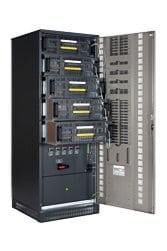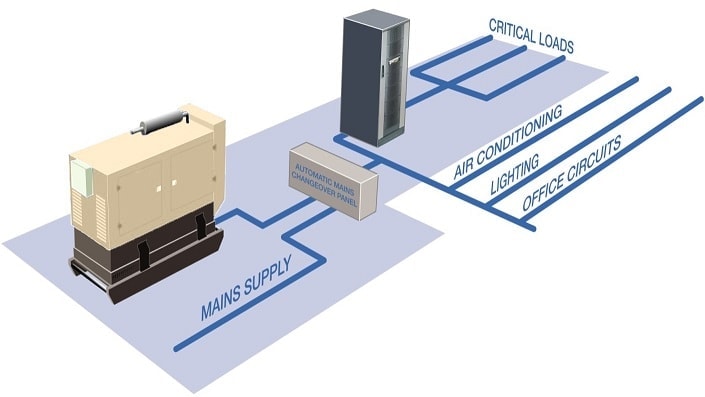Data centre sites seeking to replace legacy transformer-based UPS systems can be tempted to buy more of the same, on the basis that it is proven technology. However, an investigation of Total Cost of Ownership reveals that transformerless topology offers savings benefits due to improved operating efficiency and other factors. In this article Kenny Green, Technical Support Manager for KOHLER Uninterruptible Power, a KOHLER company explains the nature and level of savings available.
Many data centres still rely on legacy transformer-based UPS systems to secure their power availability and quality. When their operators have to upgrade or extend their UPS capability, they may be tempted to buy more of the same – after all the technology has worked reliably over many years, and appears to be cost-effective.
However it is essential to dig deeper, because transformerless systems represent a more advanced technology with many extra benefits, including a lower total cost of ownership. This is because their efficiencies of operation and other factors can soon far outweigh their additional initial purchase price. Much of this saving comes from improved power efficiency, as a simple example shows.
Improved operational efficiency
In this example, a 100kVA load is supplied by two 120kVA modules in a parallel N+1 redundant configuration. We can compare the results from a transformerless implementation with those from using transformer-based modules. In either case, each module runs at 42% load; at this level, the transformerless solution will operate at 96% efficiency while the transformer-based pair will return just 91%. If their 100kVA load has a power factor of 0.8, it will draw 80kW from the UPS. The transformer-based solution will draw 88kW from the utility mains to service this, while the transformerless UPS will take 83kW.
Simple arithmetic shows how this 5kW efficiency improvement accumulates into a worthwhile reduction over a year: 5kW x 24 x 365 = 43800kWh savings. Assuming an electricity cost price of 9.0p/kWh, this equates to a direct energy cost saving of £3942 each year. Further savings arise as the improved efficiency reduces heat losses and therefore air conditioning requirements. In this example, this could typically save a further £1000 or more over a year. Accordingly, total savings over five years from going transformerless could amount to as much as £25,000.
Going transformerless also saves costs by improving the power factor imposed on the utility mains from 0.8 to 0.98. This reduces the reactive current drawn by the UPS, therefore the sizing required for its upstream switchgear and cabling, as well as external power utility metering and possibly penalty charges.
Further cost-saving factors
Additionally, the transformerless route can start to offer savings even before installation. In the previous example, we discussed a 100kVA load supported by two 120kVA modules, paralleled to provide N+1 redundancy. This configuration means that during normal operation, 140kVA, or over half of the UPS’s total capacity, is being wasted. Yet with a legacy system where120kVA is the smallest UPS unit of capacity, the only way of improving UPS utilisation would be a single-module 120kVA implementation – and most data centres would find this loss of redundant capability unacceptable.
By contrast, a modular, transformerless UPS solution such as KOHLER Uninterruptible Power’s PW 9000DPA series could support the 100kVA load in an N+1 configuration comprising three 50kVA modules operating in inverter mode. This ‘right sizing’ reduces excess capacity from 140kVA to 50kVA, with associated savings in capital expenditure and floor space. Capacity can always be incrementally added later if expected growth in the data centre load warrants it. Meanwhile the data centre can start with a smaller, better-utilised configuration than that imposed by the legacy design, while maintaining a consistent level of redundancy.
In the PW 9000DPA example, the modularity is achieved with rackmounting units that are slotted into a single 19” floorstanding frame, as shown in Fig. 1. This can accept up to five 50kVA modules, offering 250kVA capacity, or 200kVA with N+1 redundancy. Up to five of these frames can be paralleled to achieve 1MVA capacity with N+1 redundancy.
Fig. 1: PW 9000DPA with five transformerless rack-mounting modules
Apart from ease and flexibility of scaling, Fig. 1 also shows just how compact a modular, transformerless implementation can be. This is firstly because the technology is inherently much smaller than transformer-based topologies, and secondly because right-sizing has significantly reduced waste capacity and hardware. Cost-saving implications of this start with shipping. An 80kVA 1+1 system implemented with two traditional modules would weigh about 2300 kg, occupying a gross volume of around 2.6 m3. Shipping costs for this would be double or more than those for a 2+1 modular implementation weighing about 379 kg and occupying 1.15 m3. Then, installation costs would be about 86% more for the traditional system, which would have a footprint of 1.44 m2 compared with a modular system’s 0.58 m2.
During operation, cost savings would accrue not only from the transformerless efficiency improvements as described, but also from reduced spare parts, logistics and training costs, as repairs and exchanges can be managed more easily at a modular rather than component level. Overall, the extra capex should be recovered within a year, freeing the data centre operator to enjoy ongoing efficiency savings plus the further benefits of transformerless technology.




